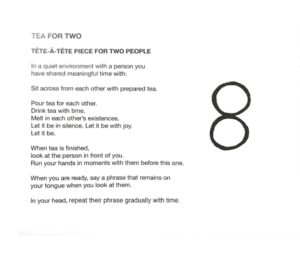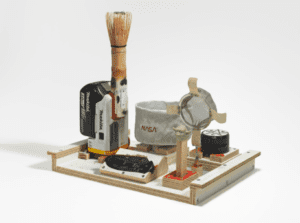Final Project: Tea for Two
For our final project, Robin and I explored the powerful meanings behind certain words and phrases, creating a performance piece called: Tea for Two. We wanted to highlight the lack of personal conversations between people, and create a catalyst for starting such interactions. Our performance piece takes the form of a tea set, an act which requires two individuals to sit down, taking time to drink and converse with one another. Along with certain prompts and instructions, we aimed to create an environment where meaningful and intimate interactions could be created.

Our final project differed from many of the classmates, as we focused on a much more experimental and abstract performance piece, rather than a more “conventional” design. We explored many ideas that both applied and strayed from the given agendas and frameworks. Although this proved to be a much harder path to take, removing ourselves from the frameworks allowed us to be unrestricted in ideating a completely new concept.

Throughout the ideation phase of our final project, Robin and I took inspiration from several different artists. Specifically for me, I drew a lot of inspiration from Tom Sachs, a contemporary artists based in New York. His “Tea Ceremony” project played an integral role in creating our project. Although the project itself is much more than a simple tea ceremony, I was especially inspired by the methodical nature of the tea ceremony portion. The intimate and personal process of pouring tea and conversing with the recipient is very appropriate for our original concept, so we decided on the tea ceremony to be our main vehicle for communicating our ideas.
However, we ran into certain issues throughout the ideation process. How would our project differ from an otherwise normal and casual conversation that occurs naturally in our environment? Is the tea ceremony truly necessary? To work around this issue, we decided to draw upon Yoko Ono’s works, creating specific scenarios and instructions in order to differentiate our project from regular conversations. These were listed in our concept video, leading participants with phrases and instructions in order to create an intimate experience with a clear intention. Although we realised we could have expanded upon this idea with even more specific instructions, to make the experience even more unique.
If we were unrestricted in time, I would have liked to expand upon certain aspects of the project. Specifically, the design of the box we presented during the presentation was merely a prototype. If given the proper time and materials, I would’ve like to build a much more relevant design to our topic and motifs, including the themes of unity and coming together. Overall, I had a really fun time working on this project with Robin, as we both pushed our own perceptions on what is design, how to communicate an idea, and I look forwards to apply these ideas in future projects.